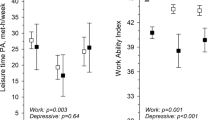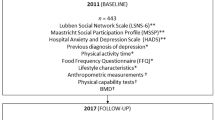Abstract
Background
Job strain has been associated with depressive symptoms, and depression has been associated with low bone mineral density (BMD).
Purpose
The associations between BMD and job strain have not been studied. We examined the relations between BMD, job strain, and depressive symptoms in a population-based group of young adults in Finland.
Method
Ultrasonic measurement of BMD at the calcaneus was performed on 777 participants (men 45 %, aged 30–45) drawn from the Cardiovascular Risk in Young Finns Study. Job strain was assessed by self-administered questionnaires by the combination of job demands and job control. Depressive symptoms were assessed with a modified Beck Depression Inventory. The effects of job strain on BMD were studied with multivariable analyses with age, sex, BMI, vitamin D, and calcium intake, physical activity, cigarette smoking, alcohol use, and depressive symptoms as covariates.
Results
Depressive symptoms were independently associated with lower BMD T score in participants with high job strain (β = −0.241, p = 0.02), but depressive symptoms were not significantly associated with BMD in the low (β = −0.160, p = 0.26) and intermediate (β = −0.042, p = 0.66) job strain categories.
Conclusion
The results suggest that job strain modifies the association between depressive symptoms and BMD. Depressed individuals with high work-related stress might be in increased risk of lower bone mineral density.

Similar content being viewed by others
References
Lane NE. Epidemiology, etiology, and diagnosis of osteoporosis. Am J Obstet Gynecol. 2006;194:S3–11.
Mauck KF, Clarke BL. Diagnosis, screening, prevention, and treatment of osteoporosis. Mayo Clin Proc. 2006;81:662–72.
Looker AC, Borrud LG, Dawson-Hughes BA, Shepherd JA, Wright NC. Osteoporosis or low bone mass at the femur neck or lumbar spine in older adults: United States, 2005–2008. NCHS Data Brief. 2012;93:1–8.
Bab IA, Yirmiya R. Depression and bone mass. Ann N Y Acad Sci. 2010;1192:170–5.
Yirmiya R, Bab I. Major depression is a risk factor for low bone mineral density: a meta-analysis. Biol Psychiatry. 2009;66:423–32.
Mezuk B, Eaton WW, Golden SH, Wand G, Lee HB. Depression, antidepressants, and bone mineral density in a population-based cohort. J Gerontol A Biol Sci Med Sci. 2008;63:1410–5.
Wu Q, Liu J, Gallegos-Orozco JF, Hentz JG. Depression, fracture risk, and bone loss: a meta-analysis of cohort studies. Osteoporos Int. 2010;21:1627–35.
Mussolino ME, Jonas BS, Looker AC. Depression and bone mineral density in young adults: results from NHANES III. Psychosom Med. 2004;66:533–7.
Diem SJ, Blackwell TL, Stone KL, Yaffe K, Cauley JA, Whooley MA, et al. Depressive symptoms and rates of bone loss at the hip in older women. J Am Geriatr Soc. 2007;55:824–31.
Cizza G, Primma S, Coyle M, Gourgiotis L, Csako G. Depression and osteoporosis: a research synthesis with meta-analysis. Horm Metab Res. 2010;42:467–82.
Whooley MA, Cauley JA, Zmuda JM, Haney EM, Glynn NW. Depressive symptoms and bone mineral density in older men. J Geriatr Psychiatry Neurol. 2004;17:88–92.
Martyn-St JM, Carroll S. Effects of different impact exercise modalities on bone mineral density in premenopausal women: a meta-analysis. J Bone Miner Metab. 2010;28:251–67.
Farr JN, Blew RM, Lee VR, Lohman TG, Going SB. Associations of physical activity duration, frequency, and load with volumetric BMD, geometry, and bone strength in young girls. Osteoporos Int. 2011;22:1419–30.
Pavey TG, Taylor AH, Fox KR, Hillsdon M, Anokye N, Campbell JL, et al. Effect of exercise referral schemes in primary care on physical activity and improving health outcomes: systematic review and meta-analysis. BMJ. 2011;343:d6462.
Kremer P, Elshaug C, Leslie E, Toumbourou JW, Patton GC, Williams J. Physical activity, leisure-time screen use and depression among children and young adolescents. J Sci Med Sport. 2013. doi:10.1016/j.jsams.2013.03.012.
Teychenne M, Ball K, Salmon J. Sedentary behavior and depression among adults: a review. Int J Behav Med. 2010;17:246–54.
Bonnet F, Irving K, Terra JL, Nony P, Berthezene F, Moulin P. Depressive symptoms are associated with unhealthy lifestyles in hypertensive patients with the metabolic syndrome. J Hypertens. 2005;23:611–7.
Bonnet F, Irving K, Terra JL, Nony P, Berthezene F, Moulin P. Anxiety and depression are associated with unhealthy lifestyle in patients at risk of cardiovascular disease. Atherosclerosis. 2005;178:339–44.
van Gool CH, Kempen GI, Penninx BW, Deeg DJ, Beekman AT, van Eijk JT. Relationship between changes in depressive symptoms and unhealthy lifestyles in late middle aged and older persons: results from the Longitudinal Aging Study Amsterdam. Age Ageing. 2003;32:81–7.
Cizza G, Mistry S, Nguyen VT, Eskandari F, Martinez P, Torvik S, et al. Do premenopausal women with major depression have low bone mineral density? A 36-month prospective study. PLoS One. 2012;7:e40894.
Bonde JP. Psychosocial factors at work and risk of depression: a systematic review of the epidemiological evidence. Occup Environ Med. 2008;65:438–45.
Stansfeld S, Candy B. Psychosocial work environment and mental health—a meta-analytic review. Scand J Work Environ Health. 2006;32:443–62.
Petronijevic M, Petronijevic N, Ivkovic M, Stefanovic D, Radonjic N, Glisic B, et al. Low bone mineral density and high bone metabolism turnover in premenopausal women with unipolar depression. Bone. 2008;42:582–90.
Altindag O, Altindag A, Asoglu M, Gunes M, Soran N, Deveci Z. Relation of cortisol levels and bone mineral density among premenopausal women with major depression. Int J Clin Pract. 2007;61:416–20.
Kirk MA, Rhodes RE. Occupation correlates of adults’ participation in leisure-time physical activity: a systematic review. Am J Prev Med. 2011;40:476–85.
Khosla S, Riggs BL, Atkinson EJ, Oberg AL, McDaniel LJ, Holets M, et al. Effects of sex and age on bone microstructure at the ultradistal radius: a population-based noninvasive in vivo assessment. J Bone Miner Res. 2006;21:124–31.
Russo CR, Lauretani F, Bandinelli S, Bartali B, Di IA, Volpato S, et al. Aging bone in men and women: beyond changes in bone mineral density. Osteoporos Int. 2003;14:531–8.
Laaksonen M, Sievänen H, Tolonen S, Mikkilä V, Räsänen L, Viikari J, et al. TCRiYFSG. Determinants of bone strength and fracture incidence in adult Finns: Cardiovascular Risk in Young Finns Study (the GENDI pQCT study). Arch Osteoporos. 2010;5:119–30.
Navarro MC, Sosa M, Saavedra P, Lainez P, Marrero M, Torres M, et al. Poverty is a risk factor for osteoporotic fractures. Osteoporos Int. 2009;20:393–8.
Asikainen TM, Kukkonen-Harjula K, Miilunpalo S. Exercise for health for early postmenopausal women: a systematic review of randomised controlled trials. Sports Med. 2004;34:753–78.
Raitakari OT, Juonala M, Rönnemaa T, Keltikangas-Järvinen L, Räsänen L, Pietikäinen M, et al. Cohort profile: the cardiovascular risk in Young Finns Study. Int J Epidemiol. 2008;37:1220–6.
Juonala M, Viikari JS, Hutri-Kähönen N, Pietikäinen M, Jokinen E, Taittonen L, et al. The 21-year follow-up of the Cardiovascular Risk in Young Finns Study: risk factor levels, secular trends and east–west difference. J Intern Med. 2004;255:457–68.
Hintsanen M, Kivimäki M, Elovainio M, Pulkki-Råback L, Keskivaara P, Juonala M, et al. Job strain and early atherosclerosis: the Cardiovascular Risk in Young Finns Study. Psychosom Med. 2005;67:740–7.
Hintsanen M, Hintsa T, Widell A, Kivimäki M, Raitakari OT, Keltkangas-Järvinen L. Negative emotionality, activity, and sociability temperaments predicting long-term job strain and effort-reward imbalance: a 15-year prospective follow-up study. J Psychosom Res. 2011;71:90–6.
Hintsanen M, Pulkki-Råback L, Juonala M, Viikari JS, Raitakari OT, Keltikangas-Järvinen L. Cloninger’s temperament traits and preclinical atherosclerosis: the Cardiovascular Risk in Young Finns Study. J Psychosom Res. 2009;67:77–84.
Elovainio M, Kivimäki M, Puttonen S, Heponiemi T, Pulkki L, Keltikangas-Järvinen L. Temperament and depressive symptoms: a population-based longitudinal study on Cloninger’s psychobiological temperament model. J Affect Disord. 2004;83:227–32.
Mansikkaniemi K, Juonala M, Taimela S, Hirvensalo M, Telama R, Huupponen R, et al. Cross-sectional associations between physical activity and selected coronary heart disease risk factors in young adults. The Cardiovascular Risk in Young Finns Study. Ann Med. 2012;44(7):1–12.
Gibson LJ. The mechanical behaviour of cancellous bone. J Biomech. 1985;18:317–28.
Cizza G, Primma S, Csako G. Depression as a risk factor for osteoporosis. Trends Endocrinol Metab. 2009;20:367–73.
Jacka FN, Pasco JA, Henry MJ, Kotowicz MA, Dodd S, Nicholson GC, et al. Depression and bone mineral density in a community sample of perimenopausal women: Geelong Osteoporosis Study. Menopause. 2005;12:88–91.
Cizza G. Major depressive disorder is a risk factor for low bone mass, central obesity, and other medical conditions. Dialogues Clin Neurosci. 2011;13:73–87.
Atteritano M, Lasco A, Mazzaferro S, Macri I, Catalano A, Santangelo A, Bagnato G, Bagnato G, Frisina N. Bone mineral density, quantitative ultrasound parameters and bone metabolism in postmenopausal women with depression. Intern Emerg Med. 2011. doi:10.1007/s11739-011-0628-1.
Ziegler R, Kasperk C. Glucocorticoid-induced osteoporosis: prevention and treatment. Steroids. 1998;63:344–8.
Acknowledgments
The excellent statistical assistance of Ville Aalto (MSc) and Irina Lisinen (MSc) is gratefully acknowledged. The Young Finns Study has been financially supported by the Academy of Finland (grant no. 124282); the Social Insurance Institution of Finland; Kuopio, Tampere, and Turku University Hospital Medical Funds; Juho Vainio Foundation; Paavo Nurmi Foundation; Finnish Foundation of Cardiovascular Research and Finnish Cultural Foundation; Tampere Tuberculosis Foundation; and Emil Aaltonen Foundation. M. Hintsanen was also supported by the Ella & Georg Ehrnrooth Foundation and Research Funds of the University of Helsinki.
Conflict of Interest
There is no conflict of interest.
Author information
Authors and Affiliations
Corresponding author
Rights and permissions
About this article
Cite this article
Oikonen, M., Hintsanen, M., Laaksonen, M. et al. Depressive Symptoms are Associated with Lower Bone Mineral Density in Young Adults with High Job Strain. The Cardiovascular Risk in Young Finns Study. Int.J. Behav. Med. 21, 464–469 (2014). https://doi.org/10.1007/s12529-013-9327-9
Published:
Issue Date:
DOI: https://doi.org/10.1007/s12529-013-9327-9




